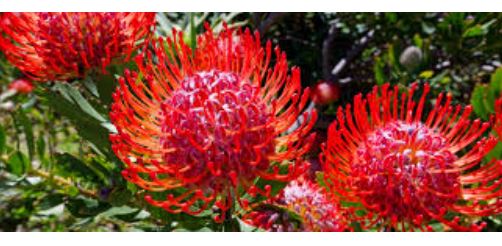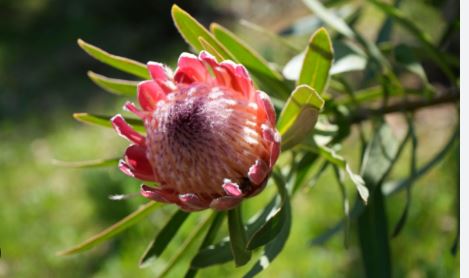
Protea flowers, native to southern Africa, are striking blooms known for their bold, sculptural shapes and vibrant colors. They thrive in warm, sunny climates with well-drained soil, making them a favorite in Mediterranean-like regions. Their unique appearance comes from colorful, petal-like bracts surrounding a dense center of tiny florets.
These flowers hold cultural significance, often symbolizing strength, resilience, and transformation due to their ability to flourish in harsh conditions. In their native regions, they’re celebrated in art, festivals, and gardens, reflecting their deep-rooted presence in local traditions.
Ecologically, proteas play a vital role in their ecosystems, attracting pollinators like birds and insects. Their tough, leathery leaves help them survive wildfires, allowing them to regenerate and support biodiversity in fire-prone areas.
In floristry, proteas are prized for their dramatic size and long vase life, often used as focal points in arrangements. Their versatility suits both fresh and dried displays, adding texture and flair to bouquets or home decor.

Varieties of Protea Flowers
King Protea (Protea cynaroides)
Identified by its massive, 12-inch bowl-shaped flower heads with vibrant pink, red, cream, or white bracts encircling a fuzzy central dome. Glossy, deep green leaves and thick stems mark this 3–5-foot shrub. Its large size and crown-like bracts distinguish it from smaller proteas.
Queen Protea (Protea magnifica)
Recognized by 6–8-inch flower heads with pink, red, or white bracts covered in a woolly, bearded texture. Grey-green leaves with red or yellow midribs grow on 8–12-foot shrubs. The bearded bracts set it apart from the smoother King Protea.
Pink Ice (Protea neriifolia x susannae hybrid)
Characterized by 4–6-inch cup-shaped blooms with frosty pink bracts and silvery-white, fringed tips. Needle-like, deep green foliage on 6–8-foot shrubs. Its silvery fringe contrasts with the bold bracts of the King Protea.
Protea Grandiceps
Characterized by its 6–8-inch bowl-shaped flower heads, Protea Grandiceps features deep pink to red bracts surrounding a prominent, feathery white central cluster. The broad, leathery green leaves, slightly glossy, grow on 4–6-foot shrubs. The feathery white center is a key identifier, setting it apart from the woolly Queen Protea, while the larger bloom size distinguishes it from the more compact Protea Brenda.
Little Prince Protea (Protea cynaroides cultivar)
Noted for its compact 2–3-foot size and 6-inch pink or white bowl-shaped bracts with a feathery center. Glossy green leaves and smaller blooms distinguish it from the larger King Protea.
Leucospermum Veldfire
With 4–6-inch pincushion blooms, it showcases yellow-orange styles that fade to striking red tips, creating a gradient effect. Dense, leathery green foliage covers 5–7-foot shrubs, adding texture. The bicolored styles set it apart from the solid-hued Pincushion Protea, and its larger size and robust growth distinguish it from the smaller Leucospermum Carnival.
Oleander-leaf Protea (Protea neriifolia)
Identified by 6-inch cup-shaped blooms with narrow, hairy bracts in pink, cream, or green, tipped with purple. Long, leathery, oleander-like leaves on 6–10-foot shrubs. Purple-tipped bracts separate it from the Queen Protea.
Protea Compacta
Protea Compacta is noted for its slender, 5–6-inch cup-shaped blooms with narrow pink to cream bracts that form a tapered, elegant structure. Its glossy, elongated green leaves, often lance-shaped, grow densely on 4–5-foot shrubs. The slim bracts make it visually distinct from the wider, bowl-shaped Special Pink Ice, and the glossy leaves contrast with the matte foliage of Protea Eximia.
Pincushion Protea (Leucospermum cordifolium)
Marked by 3–5-inch rounded flower heads with long, needle-like yellow, orange, or red styles resembling a pincushion. Bright green, rounded leaves on 4–6-foot shrubs. Its spiky styles contrast with bowl-shaped proteas.
Fiesta Protea (Protea hybrid)
Recognized by 3-inch cylindrical blooms fading from deep to pale pink, with a downy texture. Needle-like green foliage on 4–6-foot shrubs. Its unique cylindrical shape differs from the King Protea’s bowl.
Special Pink Ice Protea (Protea cynaroides cultivar)
Characterized by 8–10-inch bowl-shaped blooms with deep pink bracts and a silvery sheen. Glossy, deep green leaves on 3–5-foot shrubs. Its intense pink color stands out from the paler Little Prince.
Protea Stately (Protea compacta hybrid)
Identified by 5–7-inch deep pink bowl-shaped blooms on 4–6-foot shrubs. Leathery, green leaves and compact growth. Its vibrant bracts are bolder than Pink Ice’s softer tones.
Protea Eximia
Featuring 4–6-inch wide, bowl-shaped blooms, its rose-pink bracts curl outward, creating a flared, fan-like appearance. Stiff, green leaves with subtle red margins grow on 3–5-foot shrubs. The outward-curling bracts are unique compared to the cylindrical Fiesta Protea, and the red-margined leaves differ from the plain green foliage of Protea Susannae.
Pink Mink Protea (Protea hybrid)
Noted for 4–6-inch silvery-pink bracts with black fringes, creating a frosted look. Slender green leaves on 3–5-foot shrubs. Fringed bracts distinguish it from Special Pink Ice.
Protea Scolymocephala
Pale yellow to green bracts form 3–4-inch thistle-like blooms, small and compact. Fine, green leaves grow on 2–3-foot shrubs. The thistle-like appearance sets it apart from the larger Grandiceps, and its small size differs from most proteas.
Leucospermum Tango (Leucospermum hybrid)
Marked by 3–4-inch fiery orange pincushion blooms with upward-curving styles. Bright green foliage on 4–6-foot shrubs. Its orange hue contrasts with the yellow Pincushion Protea.
Protea Coronata
Green bracts tipped with pink or red form 5–7-inch bowl-shaped blooms. Stiff, grey-green leaves grow on 4–6-foot shrubs. The green-pink bracts distinguish it from the red-heavy Australis Ruby, and the stiff leaves contrast with softer protea foliage.
Protea Brenda (Protea hybrid)
Recognized by 5–7-inch vibrant pink blooms with a feathery center. Deep green, leathery leaves on 4–6-foot shrubs. Its bright pink bracts are more vivid than Pink Mink’s.
Leucospermum Scarlet Ribbon
The Scarlet Ribbon protea stands out with its 3–5-inch pincushion-like blooms, composed of vibrant red-orange styles that curl outward, resembling delicate ribbons. Its bright green, rounded leaves form a lush backdrop on 4–6-foot shrubs. The intense red-orange hue of the styles contrasts sharply with the softer orange tones of Leucospermum Tango, and the rounded leaves are distinct from the needle-like foliage of other hybrids.
Australis Ruby Protea (Protea hybrid)
Characterized by 4–6-inch bright red blooms with black-fringed bracts. Compact 3–4-foot shrubs with green leaves. Its red, fringed bracts differ from pink proteas.
Leucospermum Flame Giant (Leucospermum hybrid)
Identified by 4–6-inch orange-red pincushion blooms with prominent styles, like fireworks. Bright green leaves on 5–7-foot shrubs. Larger and redder than Leucospermum Tango.
Protea Pink Cream (Protea compacta cultivar)
Noted for 5–7-inch pastel pink-cream bracts. Glossy green leaves on 4–6-foot shrubs. Its soft colors contrast with the bold Australis Ruby.
Protea Amore (Protea grandiceps cultivar)
Recognized by 5–6-inch peach-colored bracts with red undertones. Leathery green leaves on 3–5-foot shrubs. Its warm peach-red tones set it apart from Brenda’s pink.
Protea Susannae
This protea is distinguished by its 4–6-inch cup-shaped flower heads, featuring soft pink to apricot bracts that encircle a woolly, dome-like central mass of florets. The narrow, grey-green leaves, often slightly curved, grow densely on 3–5-foot shrubs, giving the plant a compact appearance. The pastel bracts and fuzzy center set it apart from the bolder, more vibrant King Protea, while the leaf shape differs from the broader foliage of Protea Grandiceps.
Protea Laurifolia
This protea has 5–7-inch cup-shaped blooms with grey-pink bracts surrounding a distinctive black-bearded central dome. Long, laurel-like grey-green leaves grow on 6–8-foot shrubs, giving a sleek look. The black beard is a standout feature, unlike the purple-tipped Oleander-leaf Protea, and the laurel-like leaves contrast with the broader leaves of Protea Grandiceps.
Leucospermum Carnival
Bright yellow styles tipped with red form 3–4-inch pincushion blooms, creating a festive contrast. Compact, green rounded leaves grow on 4–5-foot shrubs. The yellow-red combination distinguishes it from the orange-heavy Flame Giant, and its smaller, denser blooms differ from the larger Veldfire.
Protea Aristata
Narrow red bracts with white, feathery tips form 4–5-inch cone-shaped blooms, giving a spiky appearance. Slender, green leaves grow on 3–4-foot shrubs. The conical shape and white-tipped bracts set it apart from the softer Pink Cream, while the slender leaves differ from the broader foliage of Protea Obtusifolia.
Protea Repens
Known as the sugarbush, it features 3–5-inch tubular blooms with sticky red to cream bracts. Needle-like green leaves grow on crawling 2–3-foot shrubs. The sticky bracts are unique compared to the non-sticky Little Prince, and its low, sprawling growth contrasts with upright proteas.
Leucospermum Moonlight
Soft yellow styles fading to cream form 4–5-inch pincushion blooms, creating a gentle glow. Broad, grey-green leaves cover 5–6-foot shrubs. The pale tones contrast with the vibrant Scarlet Ribbon, and the broad leaves differ from the rounded foliage of Leucospermum Goldie.
Protea Mundii
Creamy-white bracts with pink tips create 4–6-inch slender, cup-shaped blooms. Long, narrow green leaves grow on 6–8-foot shrubs. The white-pink bracts are distinct from the bold pink Brenda, and the narrow leaves contrast with the broader foliage of Protea Compacta.
Leucospermum Goldie
Golden-yellow styles create 3–4-inch pincushion blooms, vibrant and uniform. Rounded, green leaves grow on 3–4-foot shrubs. The solid gold color contrasts with the bicolored Veldfire, and its compact size differs from the larger High Gold.
31. Protea Obtusifolia
Glossy red to white bracts form 5–7-inch cup-shaped blooms, shiny and bold. Broad, rounded green leaves grow on 4–6-foot shrubs. The glossy bracts contrast with the woolly Queen Protea, and the rounded leaves differ from the narrow foliage of Protea Mundii.
Protea Sulphurea
Sulphur-yellow bracts create 3–5-inch drooping, cup-shaped blooms, nodding downward. Soft, green leaves grow on 2–3-foot shrubs. The drooping shape is unique compared to the upright Pink Mink, and the yellow hue contrasts with red proteas.
Leucospermum High Gold
Bright yellow styles with orange tips form 4–5-inch pincushion blooms, vivid and striking. Dense, green foliage covers 4–6-foot shrubs. The yellow-orange tips differ from Moonlight’s softer tones, and its dense foliage contrasts with Carnival’s compact leaves.